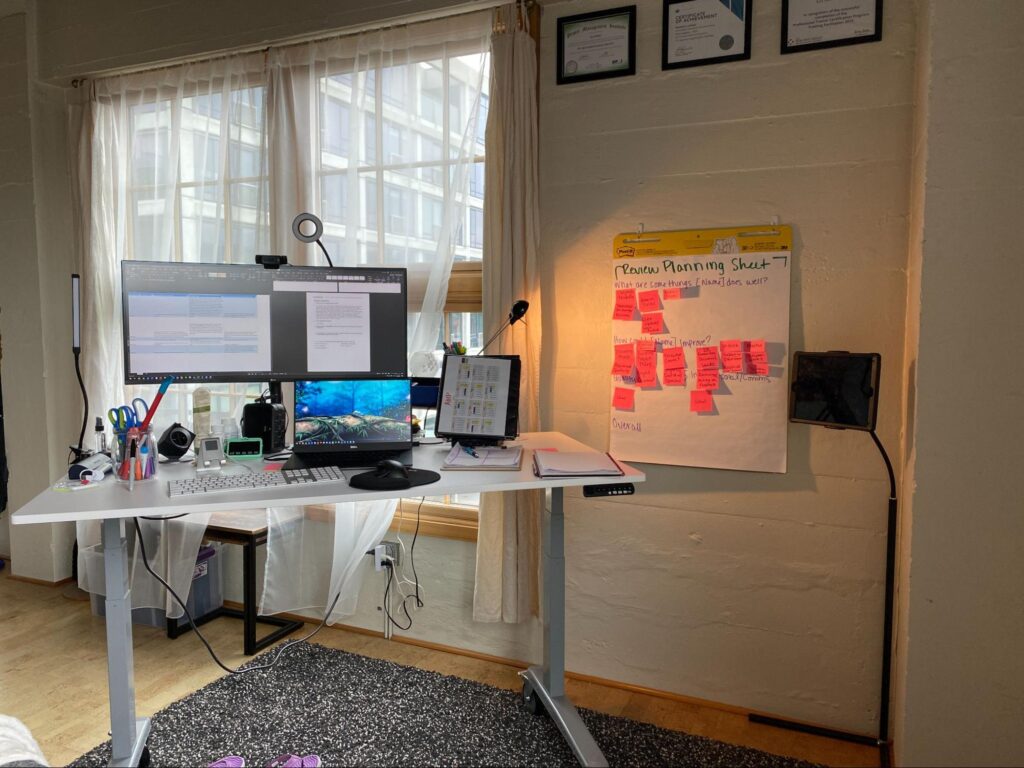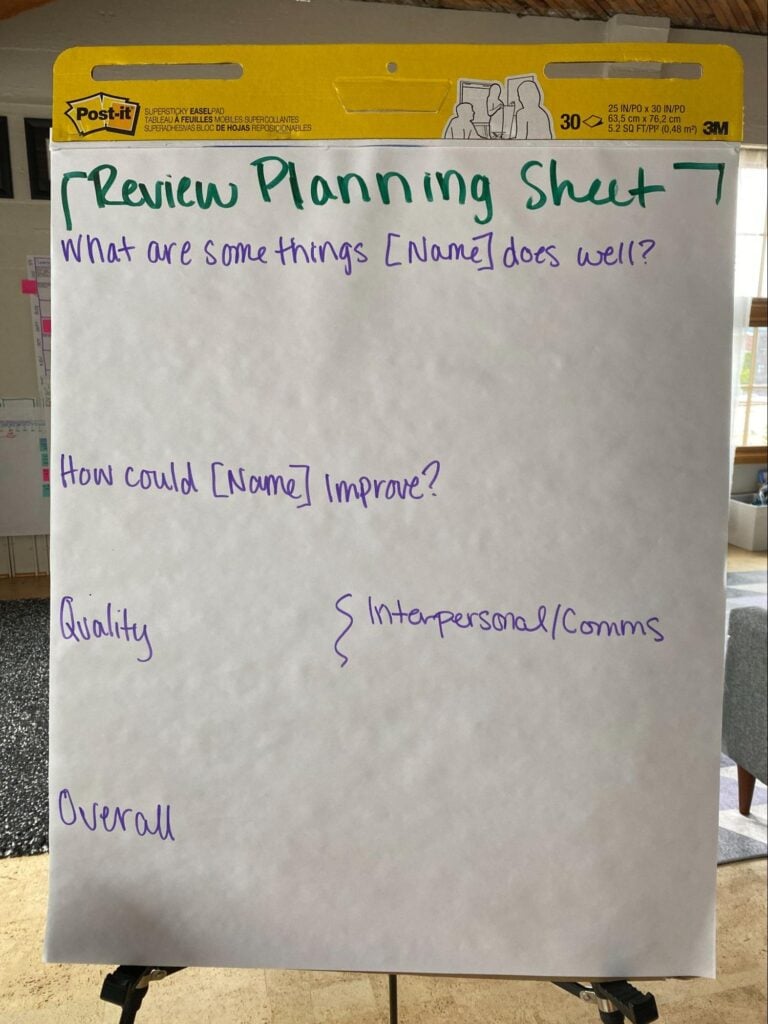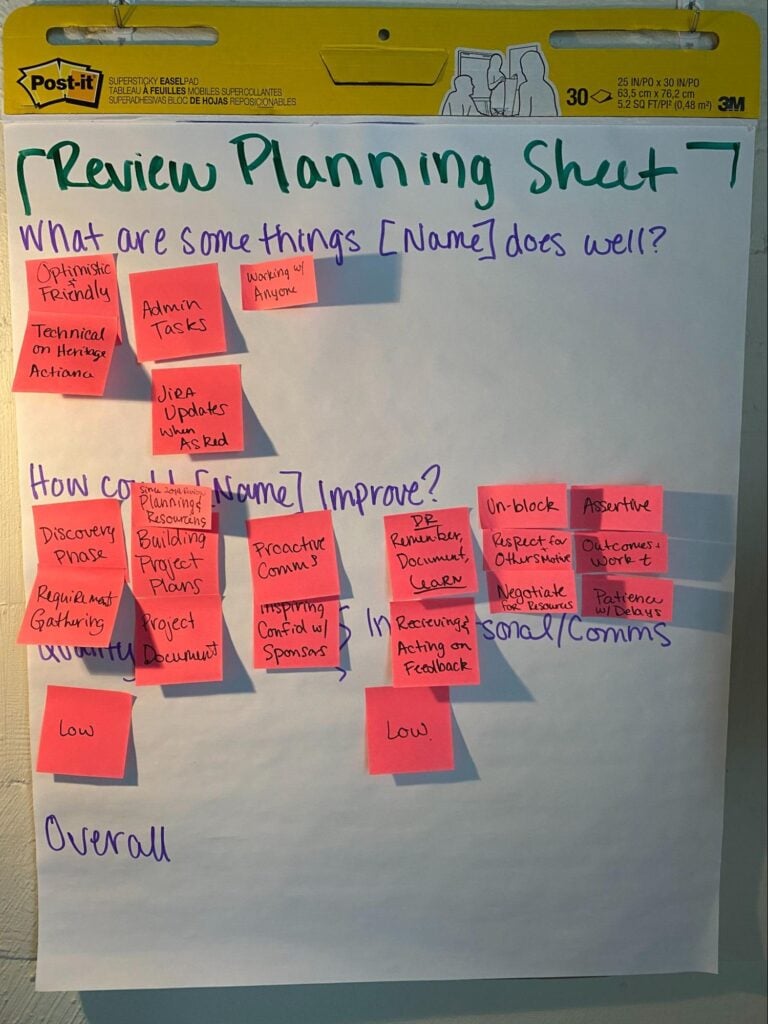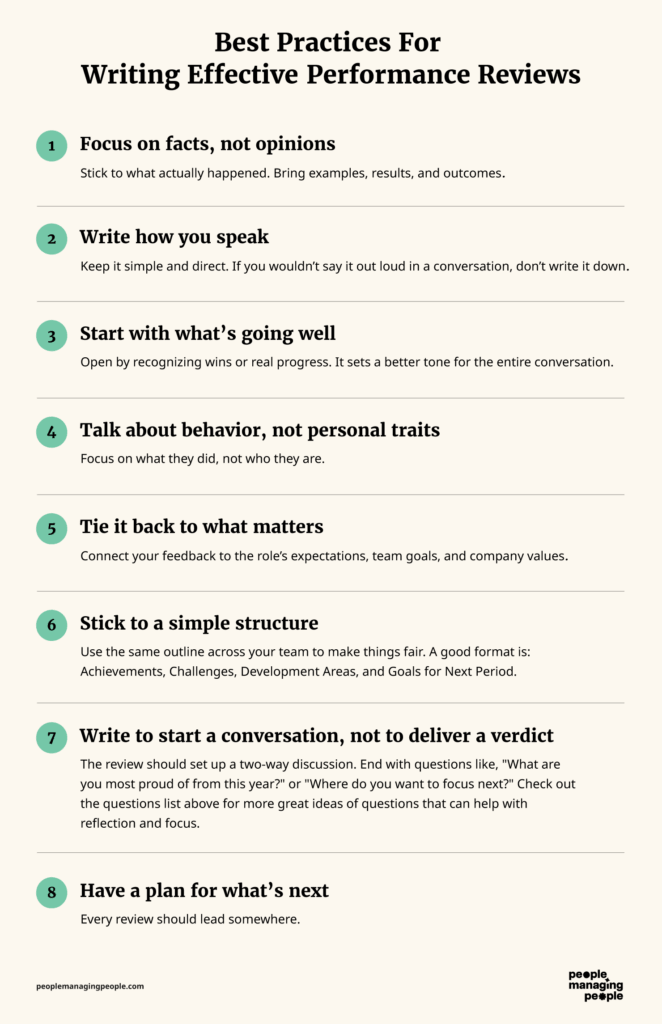Perhaps surprisingly, performance reviews are one of my favorite things I get to do as a manager.
In my personal opinion, managers who dread them just haven’t gotten into the groove of doing them well yet!
Once you get the hang of writing performance reviews, you will unlock next-level coaching and development of your people.
Most performance reviews fail because they are rushed, vague, and/or disconnected from real work.
Based on years of experience leading teams and coaching managers, I will show you how to write performance reviews that are thoughtful, fact-based, and set a clear path for future growth.
What Is A Performance Review?
A performance review is a structured conversation between a manager and an employee as part of a performance management process.
It's a chance to take a step back, look at what’s working, talk honestly about what’s not, and decide how to move forward.
Done right, it's not just a process—it’s a moment to reconnect and make sure both people are aligned on the work, the expectations, and what success looks like going forward.
Let’s get one thing straight: a performance review should never be the first time someone hears about a problem.
If you’re holding back important feedback until review time, you're not doing your job as a manager.
Ongoing feedback is essential. The formal performance review is the summary, not the surprise.
A good performance review should do four things:
- Highlight the employee’s strengths and recent impact
- Identify specific areas for improvement or support
- Adjust goals or expectations based on what's changed
- Reinforce the manager’s role in helping the employee grow.
It’s about being thoughtful. Think about the role, the expectations, the environment and the performance of the individual. And pull data, reflect on real examples, and ask for input from others if you don’t see the day-to-day.
Never wing it.
If you find yourself scrambling through project files or scrolling Slack five minutes before the meeting, take that as a sign to block more time and treat this process with the care it deserves.
How To Write Employee Performance Reviews
Now into the nitty gritty of writing a performance review. While rating scales and templates will differ across orgz, from my experience this process help both team members and managers get the most out of the process.
1. Reflect on your team and employee’s performance
Before you write anything, take the time to really reflect. Don’t just open the review template and start filling in boxes.
The best reviews begin with thoughtful consideration—what’s happened, how the person has contributed, and what it all means in context.
Look back over the review period and consider the full picture. Start with outcomes—What did this person actually accomplish? Did they meet their goals, exceed them, or miss the mark?
Don’t stop at the numbers, though. Think about how the work was done. Did they collaborate well? Show up consistently? Step in when things got tough?
Then zoom out and consider the team as a whole.
How does this person contribute to the group dynamic? Do they help move the work forward, or do they create friction? Are they the person others turn to for support, or do they tend to operate on the sidelines?
Sometimes the biggest impact isn’t found in project updates or status reports—it’s in the way someone helps others succeed.
If you’re not working closely with the person day to day, you need to go a layer deeper. Gather input from people who are.
I’ve used short feedback forms, one-on-one check-ins with peers, 360-degree feedback surveys and even casual conversations to collect insights.
A few thoughtful comments from those who see the person’s work up close can make a huge difference in shaping an honest and well-rounded review.
Also, in many companies, employees also complete a self-review as part of the process. If that’s the case, don’t read it too early, do your own reflection and data gathering first then use the self-review to compare perspectives, spot alignment or gaps, and understand how the employee sees their own progress.
It’s not about matching answers—it’s about learning something new. Here are a few things I look for during my reflection:
- Key contributions and outcomes the person drove
- Behavioral patterns that stood out (positive or negative)
- Feedback I’ve already given throughout the year (continuous feedback is a must!!)
- Any gaps between expectations and actual performance
- What I’ve observed, versus what others have experienced
One thing that’s really helped me in this step is creating a physical space to reflect.
I don’t do this work sitting at my regular desk, instead I like to use a flip chart and sticky notes.
I stand up, clear my mind, and create space to think about each person’s performance without distractions.
I jot down observations on individual sticky notes—things like project wins, missed deadlines, strengths in team communication, or growth areas they’ve been working on. Each sticky note goes up on the chart, one by one:



After I’ve done that for everyone on my team, I can step back and literally see the patterns.
It gives me a more complete picture of the person and helps me organize my feedback before I ever start typing. It also keeps me grounded in facts and context, not just how I’m feeling that day.
If you’re stuck, ask yourself this:
- What would be different if this person wasn’t on the team?
- What have they made better, easier, or more successful for others?
This is not about perfection. It’s about understanding the full scope of someone’s contribution and preparing to talk about it with clarity and care.
2. Draft your feedback and link it to the expectations of the role
Once you’ve done your reflection, it’s time to start writing. Use your notes to begin filling in the performance review outline or template.
Don’t start from a blank page—use structure to guide your thinking and make the review easier to write and easier to read.
If your company provides a performance review template, use it. No need to reinvent the wheel, most will include space to comment on goals, strengths, development areas, and overall performance.
If no template is provided, create your own. Here’s a simple version I recommend:
- Key accomplishments
- Strengths
- Areas for improvement
- Progress toward goals
- Feedback from others
- Next steps and support.
This gives you a clear outline to follow, and makes sure nothing important gets left out.
When drafting feedback, tie it back to the expectations of the role, based on the job description (and if you don’t have a job description for the role, it’s time to fix that…).
What are the core responsibilities? What does “good performance” look like in this position? Are they meeting the standard, exceeding it, or falling short?
Be specific and use examples, and avoid vague language like “great attitude” or “needs to communicate better.”
Instead, write what happened, what it impacted, and what needs to change.
Example: “In Q2, Jasmine led the system migration project and kept it on track despite multiple vendor delays. Her proactive communication with both IT and the business team helped avoid further downstream delays. This is a strong example of project ownership and cross-functional collaboration.”
Or: “Chris frequently missed deadlines during the budgeting cycle, which delayed our finance reporting and caused extra work for the analyst team. We need to see more proactive planning and consistent follow-through on deliverables.”
Every point should connect to what’s expected in the role and what matters most to the team and organization. That’s how performance becomes actionable, not just observed.
Once you’ve drafted the review, read it back to yourself and ask:
- Does this clearly reflect their performance?
- Would they be surprised by any of this?
- Can I stand behind every statement with examples?
This step takes time, but it’s where the review starts to come into focus. Be honest, be thorough, and be clear.
You're not just describing what happened—you're helping someone understand how they're doing and what comes next.
As you do this, be sure to keep the HR folks in your life happy and submit your feedback on-time, in the format HR requested, and in the performance management tool of their choice. Don’t make HR chase you for your performance reviews!
3. Prepare to deliver the performance review
Once you’ve gone through the activity to draft the review and submit it in the right way, it’s time to get ready for the conversation you will have with the employee you wrote the review about!
Similarly to the written feedback, don’t wing the conversation (even though you DID write the feedback, this part still needs prep).
Set aside focused time to prepare—not just to reread what you wrote, but to think about how you want the conversation to go and how your conversations with the employee have gone in the past. A great review meeting isn’t just about reading the narrative out loud, it’s about having a thoughtful, two-way conversation.
Think about your goals going in.
- What do you want the employee to take away from this conversation?
- Where do you want them to feel proud?
- Where do you want them to reflect and improve?
- How do you want them to feel when they leave the meeting?
I like to start by highlighting progress. Reinforce strengths and meaningful contributions early. When you begin with what’s going well, it creates space for openness, reflection, and trust.
From there, shift into areas for improvement with clarity, not judgment. Share the impact of any issues, and be specific about what needs to change and why.
If you’re delivering tough feedback, plan ahead for how you’ll say it. Don’t avoid it. Don’t sugarcoat it. But do come in prepared to have a conversation—not just to deliver a verdict.
This includes anticipating how the employee might respond. If they’ve struggled, they hopefully already know. If they’re caught off guard, they may need time to process. Remember, no surprises!!
Here’s what I do in practice:
- I block time on my calendar to review my notes a day or two before the meeting
- I revisit the goals, metrics, and key themes from my draft
- I rehearse or jot down the most important messages I want to land
- I send the written review just before the conversation begins so the employee can read and process my written feedback just before entering the meeting with me.
That last one might sound unusual, but it works.
When both the employee and I bring our written reviews into the conversation—without having read each other’s ahead of time—it creates a more honest and balanced discussion.
We call this a double-blind review. It’s one of my favorite ways to keep the process fair and focused.
Performance reviews shouldn’t be one-sided. This is a shared conversation so ask questions, invite reflection and make space for the employee to share their perspective, too.
Try asking:
- What felt most meaningful about your work this period?
- Where did you feel like you struggled?
- What support would help you grow this quarter?
The best performance conversations are grounded, open, and clear. You’re not performing. You’re partnering together to develop each other to be the best you can be as employees, a team and an organization.
4. Conduct and update based on discussion
Once you've drafted the review and prepared for the conversation, the next step is to lead an effective dialogue.
Performance reviews often come with a lot of historical baggage—employees might expect the conversation to be one-sided, overly formal, or focused only on what went wrong.
Your job is to break that pattern right away.
Start with intention, this isn’t just a reading exercise, you’re here to talk about performance, alignment, growth, and what comes next.
Set the tone early by sharing what you hope to cover, and give the employee a chance to share their own goals for the conversation too.
Here’s a simple way to open:
"Today is about discussing your impact, where you’re seeing progress, and where we can focus next. I’ll share my feedback, but I also want to hear your perspective.
The goal is to have an honest conversation about where things are working, where they can get better, and how we can move forward together."
Stick to the outline you prepared, but don’t be rigid. Let the conversation unfold.
If the team member brings up something unexpected or meaningful, follow that thread. This is where the real value of a performance review often shows up—in the stories, reflections, and insights that weren’t written down ahead of time.
Be sure to pause throughout and ask questions to better understand the employee’s view of their performance, the work environment, and how you can help them to be successful (keep reading for a set of example questions that can help you get started)!
If you're using the double-blind method, take time to review both versions—yours and theirs—together.
Note the areas where you're aligned, and talk through the differences with curiosity, not defensiveness.
Sometimes the most helpful part of the conversation is finding out what each person noticed—or didn’t.
As the conversation wraps up, summarize what you both heard and agreed on. Then update the written review, if needed, based on the discussion. This might include:
- Clarifying context around a performance example
- Rewriting a development goal to reflect new input
- Adjusting language to reflect alignment or resolution.
Make sure the final version reflects the whole conversation—not just your initial draft.
When the team member revisits the review later, it should feel accurate, fair, and useful. Not just what you thought before you walked into the room.
Lastly, document any follow-up. If there’s a new goal, a support plan, or a shift in expectations, write it down and make it easy to track.
Your future self (manager brain is tough when doing multiple reviews, and your employee (who at this time is focusing on “passing” the review), and HR (who is trying to make sure proper documentation is done across the board), will thank you.
Effective Performance Review Questions and Action Items
When engaging in a performance discussion, questions can be super helpful as they help you check for understanding, open space for reflection, and stay aligned.
You don’t need to ask every question on this list! Pick the ones that fit the person, their role, and the goals of the review.
20 Performance Review Questions with Purpose!
Every question you ask during a performance review should have a clear purpose. Your questions should help you either:
- Uncover insights you would not otherwise know
- Confirm or challenge the assumptions you made when drafting your review
Choose your questions carefully based on what you already know—and where you still have gaps to explore.
Avoid framing questions in a way that feels accusatory or puts the employee on the defensive, the best questions center around strengths, achievements, growth, and future aspirations.
The goal is to understand how the employee sees their work, where they feel strong, and what will help them continue to succeed.
If you find yourself preparing for a conversation that feels more focused on performance issues than growth, it may be time to involve your HR partner and consider a different approach.
Here are examples of thoughtful, forward-looking questions you can use in your next performance review conversation.
Quality of work
- Which accomplishments this period are you most proud of?
- Where do you feel your work made the greatest impact?
- What practices or habits have helped you consistently deliver high-quality work?
- If you had more time or resources, where would you take your work to the next level?
Teamwork
- When have you felt most connected to the team’s success?
- What helps you collaborate most effectively with others?
- Are there any opportunities you see to build even stronger partnerships across the team?
- Who has supported your success recently, and how have you supported others?
Communication
- What communication approaches have worked well for you in achieving your goals?
- Can you share an example where your communication helped drive clarity or progress?
- Where do you feel most confident communicating, and where would you like to build even more influence?
- What feedback have you received about your communication that you found helpful?
Ownership and Accountability
- Tell me about a time when you took initiative that had a positive result.
- How do you set yourself up for success when managing your projects or responsibilities?
- What systems or approaches have helped you stay accountable to your goals?
- Where would you like even more ownership or leadership opportunities moving forward?
Growth and development
- What new skills or experiences have you built that you’re excited about?
- What strengths do you want to continue developing over the next 6–12 months?
- Are there skills or experiences you’re interested in exploring that we haven’t yet discussed?
- How can we better align your growth with your career goals?
Feedback and manager support
- What kinds of support or feedback have helped you perform at your best?
- How can I better support your work, your development, or your goals?
- Are there additional resources, tools, or experiences that would help you grow faster?
- How would you like us to work together in the coming months to keep you progressing?
Alignment and motivation
- What parts of your work feel most motivating and meaningful to you right now?
- Where do you feel most aligned with the team’s goals and mission?
- Are there areas where you’d like to make an even bigger impact?
- What would make the next phase of your work even more energizing?
When you use these questions in a performance conversation, be sure to listen actively and take notes on what confirms your observations and what reveals something new you didn’t expect.
If the employee’s answers line up with your initial review, you can move forward with confidence. If they surface new information, adjust in real time. That’s the real value of a good performance review conversation: not just validating your own view, but learning something you couldn’t see on your own and helping your employee and the organization move forward confidently.
10 performance review action items
Every review conversation should result in clear next steps. You’re not just summarizing the past—you’re helping the employee move forward with purpose.
Here are action items you can include to help guide employee performance and growth.
As you look to use these items, choose only what’s relevant, and make sure each item ties back to the job description/role or goals of the position.
To build on strengths
- Assign a leadership role on an upcoming project
- Ask them to coach or mentor a teammate in a skill they’ve mastered
- Encourage them to document a best practice and share it with the team.
To address gaps in performance
- Set a focused improvement goal tied to specific work outcomes
- Schedule peer reviews or shadowing to build exposure and skill
- Provide access to relevant training or development resources.
To support readiness for a promotion or raise
- Identify the key responsibilities of the next-level role and assign one
- Establish clear, measurable criteria for growth and revisit monthly
- Track wins in a shared space to support promotion conversations.
To stay aligned
- Set a regular check-in to revisit goals and offer feedback
- Align goals (the more specific and measurable, the better!) or key priorities with what you discussed in the review.
Throughout each of these action item areas, always be specific. Write the action items down. Follow up on them with the employee in the next 1:1. This is how you turn a great performance review into real employee development.
Best Practices For Writing Effective Performance Reviews

Writing a strong performance review means creating something useful for the employee. A great review should feel clear, fair, actionable, and motivating.
Here’s what to focus on:
- Focus on facts, not opinions: Stick to what actually happened. Bring examples, results, and outcomes. (Example: "Completed three major projects on time and under budget" is useful. "Seems motivated" doesn’t tell anyone what they need to know.)
- Write how you speak: Keep it simple and direct. If you wouldn’t say it out loud in a conversation, don’t write it down. (Example: "Works well across teams to get results" is better than "demonstrates cross-functional synergy.")
- Start with what’s going well: Open by recognizing wins or real progress. It sets a better tone for the entire conversation. (Example: "You’ve built strong relationships across the team, and it’s made a real difference in project handoffs.")
- Talk about behavior, not personal traits: Focus on what they did, not who they are. (Example: "Missed a project deadline, which delayed the rollout by two weeks" is clear. Saying "is unreliable" isn’t helpful and feels like a personal attack.)
- Tie it back to what matters: Connect your feedback to the role’s expectations, team goals, and company values. (Example: "Your ownership of client issues this quarter directly supports our customer-first value.")
- Stick to a simple structure: Use the same outline across your team to make things fair. A good format is: Achievements, Challenges, Development Areas, and Goals for Next Period.
- Write to start a conversation, not to deliver a verdict: The review should set up a two-way discussion. End with questions like, "What are you most proud of from this year?" or "Where do you want to focus next?" Check out the questions list above for more great ideas of questions that can help with reflection and focus.
- Have a plan for what’s next: Every review should lead somewhere. (Example: "Let’s schedule a check-in next quarter to support your goal of leading larger projects.")
What To Avoid During Performance Reviews
Even when you prepare well, there are some common mistakes that can weaken the impact of your conversation. Keep these in mind and steer clear.
- Being vague or generic: Specific feedback is what helps people improve. Without examples, your message feels forgettable—or worse, confusing. (Example: "You need to work faster" is vague. "I noticed several reports were delayed last month because approvals were missed" gives something real to work from.)
- Focusing only on the negative: If the whole conversation is about problems, it’s hard for anyone to leave motivated. Recognize progress and impact alongside areas for growth.
- Comparing employees: Reviews are about performance against role expectations, not who’s better or worse on the team. Comparisons create resentment and damage trust.
- Rushing the conversation: A rushed review signals that their work—and growth—aren’t a priority. Block real time. Be present.
- Making it one-sided: Reviews are better when they’re a dialogue, not a monologue. Ask good questions, listen, and make space for their perspective too.
- Overweighting recent events: Don’t just review what happened last month. Step back and consider the whole performance period but be sure not to carry over anything that happened before this current performance period if it was already addressed in a previous review. Running quarterly reviews can help ensure feedback is timely.
- Skipping the follow-up: Without clear next steps, even a great conversation can lose momentum. Write down goals, development plans, and any resources they need—and follow up.
Done well, a performance review shows someone where they’re strong, where they can grow, and how you’ll support them to get there. It is your job as a people manager to help your employees reflect, determine development goals and move towards greatness!
Make Performance Reviews a Strength, Not a Struggle
Performance reviews should be a catalyst for growth, not a box to check. When you take the time to do them right, you build trust, boost results, and help your people grow.
As a next step, maybe check out Mariya Hristova's excellent article on performance reviews best practices to help ensure they're as productive and efficient as possible.
If you want more tools to lead with clarity and impact, Subscribe to the People Managing People newsletter and get expert advice and actionable resources to up-level your leadership!




